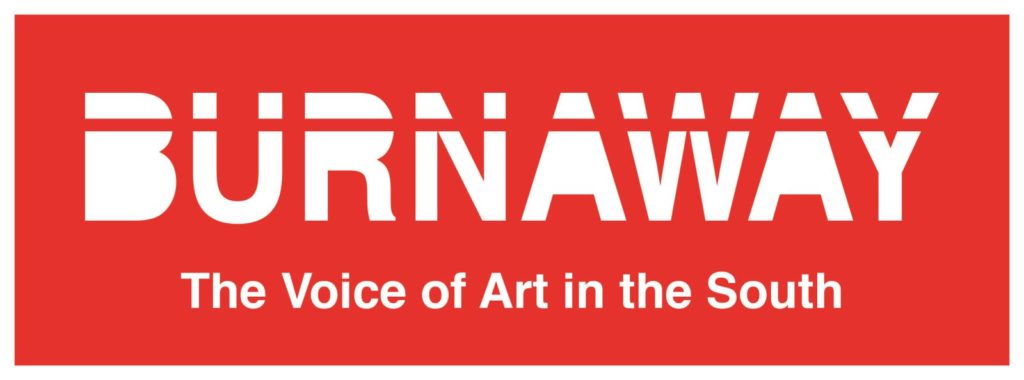for Burnaway |

Gregor Turk’s seemingly simple, utterly arresting public artwork Apparitions overlooks the Atlanta BeltLine at Piedmont Park’s northern edge, a short walk west of Monroe Drive. Because the work, on view through the end of July (possibly longer), depicts gargantuan sets of human eyes on billboards, the previous sentence’s verb applies structurally and anthropomorphically. Possibly because of whose eyes the work reproduces, and probably because it stands in a vegetation-shrouded glade, but almost certainly because it exists on unfenced public property, the work has attracted the attention of one or more vandals.
Turk, in describing Apparitions to me, associated the marks that now overlay one set of photo-derived eyes to his revelation that in life they belonged to General William Tecumseh Sherman, who ordered the 1864 burning of Atlanta. The artist could be correct in thinking the iconoclast’s motivation is related to post-Confederate pride or wrath: Earlier stages of the work were photos of actual blank billboards and then of patches of forest obscured by Turk’s own billboards, all of which went unmarred for months. Short of a confession or self-explanatory graffito, the why behind the pair of gilt-paint asterisks “blinding” the general is likely to remain a mystery. I wanted to believe that the “reason” probably stemmed from the same mean-spirited illspring that brought about the destruction in 2010 of Larry Jens Anderson’s LGBT rights-themed BeltLine installation Locked Out.
A likelier-but-no-less-speculative explanation in our panopticon age would be that someone lashed out at an emblem evocative of surveillance in a secluded stretch of almost-woods. Turk, in a 2013 talk with BURNAWAY, cited the all-seeing T.J. Eckleburg signage (giant eyes gazing upon the Valley of Ashes) from The Great Gatsby as one of this project’s influences.
Here are some questions that strike me as more fruitful but equally tough to answer in this episode and others like it: Whose surfaces are the surfaces of public art, anyway? Where is the line between suppressive iconoclasm and graffitied commentary? What body, if any, gets to make such determinations—property owners, local government, “artocrats,” or perhaps a league combining all three?
Consider the 2012 clash involving members of three such groups—residents of Atlanta’s Pittsburgh neighborhood, the Georgia Department of Transportation, and Living Walls—over a Pierre Roti mural. Initially called demonic and later merely presumptuous by locals who objected to it, the work ultimately had to be painted over because it inadvertently occupied a wall controlled by GDOT and violated a policy against divisive public art. Most interesting to me in that episode was the afternoon during which volunteers tried to save the work after its unauthorized whitewashing by citizens who saw the art itself as unauthorized by the community; the volunteers got the help of personnel with water trucks from GDOT, the same organization that later condemned the mural to being, again, whitewashed. The bureaucratic hand gives and it takes away, sometimes absent anything like the proprioception that “informs” fully functional real hands of each other’s actions.

Other actors exist in the same sphere alongside public art, however. I refer, of course, to the public. Commuters. Passersby. Spray-painters. Vandals. Members of the transient public come in as many flavors as artists do. When the arts collective Eyedrum (on whose board I serve as vice chair) offered Tatyana Fazlalizadeh space on its new facade for her provocative feminist wheat paste posters, I knew graffiti would follow. Sure enough, within a few weeks someone markered fairly predictable opinions about women, their presumptive roles, and self-respect into the white space of a single poster. No surprise there (other than how remarkably dull the graffiti proved to be). What initially disappointed me and other Eyedrum personnel was a subsequent commenter who saw fit to cross out the dull stuff, in addition to contributing writing that was equally unimaginative. A re-examination of the added text left me wondering whether the same person might have rethought earlier comments—which would be okay with me.
Artists seem to understand that a work of art exists as a part of a never-ending conversation—as statement or reply, parody or tangent. Erasure of others’ material, whether crossing out the words of a predecessor or demolishing a work overall, is rare in the realms of art. If there could ever be an aspect of art that life was compelled to imitate, I wish it could be one similarly respectful of civil communication.
Ed Hall wishes that every reader of this essay would rush right out to see Apparitions and leave behind not even a jot of ink.
Original article on burnaway.com
